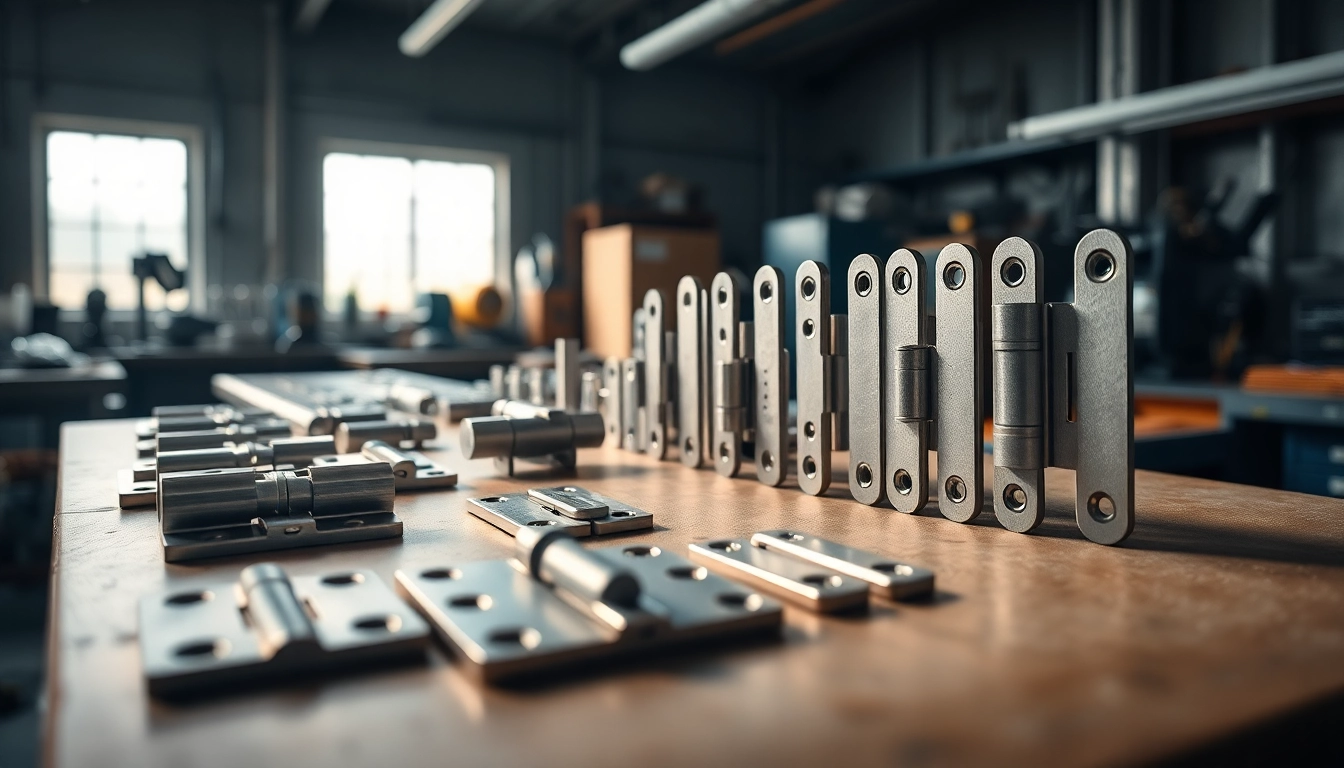An Overview of Cabinet Hinge Manufacturers
Cabinet hinges play a crucial role in the functionality and aesthetics of kitchen and bathroom cabinetry. These seemingly simple devices allow for the smooth operation of cabinet doors, contributing to a seamless user experience. With the growing emphasis on home improvement and DIY projects, Cabinet Hinge Manufacturers are facing increasing demand for innovative, high-quality hinges. This article explores the types of cabinet hinges available, profiles leading manufacturers in the sector, and provides insights into selecting the right hinges for your needs.
Defining Cabinet Hinges and Their Importance
Cabinet hinges are mechanical devices that attach the cabinet door to the frame, allowing for the door’s rotation about a fixed axis. Their design influences the overall functionality of cabinetry, affecting aspects such as accessibility, aesthetics, and durability. Hinges are vital for both residential and commercial applications, providing support and promoting efficient use of space.
Types of Cabinet Hinges Available
There are several types of cabinet hinges, each designed for specific applications and styles:
- European Hinges: Also known as concealed or hidden hinges, these are commonly used in modern cabinetry. They provide a clean, sleek look, as they are installed inside the cabinet and are not visible when the door is closed.
- Overlay Hinges: These hinges are used when the cabinet door overlaps the cabinet frame. They are available in various styles and are commonly found in traditional cabinetry.
- Inset Hinges: Designed for cabinets where the door sits flush with the frame, inset hinges provide a more built-in appearance.
- Pivot Hinges: Ideal for larger doors, pivot hinges allow the door to swing out from a central point, offering a unique opening mechanism.
- Soft-Close Hinges: A popular choice for modern cabinetry, soft-close hinges prevent doors from slamming shut, promoting longevity and a quieter kitchen experience.
The Manufacturing Process of Cabinet Hinges
The production of cabinet hinges involves multiple stages, ensuring quality and precision. This process generally includes:
- Material Selection: Manufacturers typically use steel, brass, or stainless steel for durability.
- Manufacturing: Using computer numerical control (CNC) machines, manufacturers cut and shape materials into precise hinge components.
- Finishing: Components undergo finishing processes, including plating or powder coating, to enhance corrosion resistance and aesthetics.
- Assembly: Individual parts are assembled into functioning hinges, often testing for quality at different stages.
- Quality Control: Rigorous testing ensures that each batch meets the required standards for strength, durability, and functionality.
Key Players in the Cabinet Hinge Market
Leading Manufacturers and Their Unique Offerings
Several key players dominate the cabinet hinge market, each offering a unique value proposition:
- Blum: Renowned for their innovative soft-close mechanisms, Blum combines functionality with aesthetic appeal. Their hinges are designed to provide seamless, quiet closing, enhancing the user experience.
- Grass: Known for their advanced technology and precision engineering, Grass hinges accommodate a wide variety of cabinet styles while maintaining durability and ease of use.
- Amerock: A leader in cabinet hardware, Amerock offers a diverse range of cabinet hinge styles, ensuring compatibility with various home designs.
- Salice: This manufacturer specializes in concealed hinges, providing elegant solutions for modern cabinetry needs.
Comparing Quality and Pricing Strategies
Quality in the cabinet hinge market is often defined by material resilience, engineering precision, and longevity. When comparing manufacturers, it’s crucial to evaluate their product warranties and customer reviews. Typically, high-end hinges come with a steeper price tag, reflecting the quality and technology incorporated. However, budget options may also provide acceptable performance for less demanding applications.
Small vs. Large Scale Manufacturers
The cabinet hinge industry comprises both small bespoke manufacturers and large-scale producers. Small manufacturers often focus on niche markets, offering custom solutions tailored to specific client needs. In contrast, larger companies benefit from economies of scale, allowing them to reach a broader market at competitive prices. Each type has its advantages and challenges, influencing factors such as product availability, pricing, and service quality.
Choosing the Right Cabinet Hinge for Your Needs
Factors to Consider When Selecting Hinges
When selecting cabinet hinges, consider the following factors:
- Type of Cabinet: The cabinet’s design and intended use will largely dictate the type of hinge required. For instance, heavy cabinet doors may necessitate robust hinges to bear the load.
- Style: Hinges should complement the overall design aesthetic of your cabinetry. Modern designs typically favor concealed hinges, whereas traditional styles may call for more decorative options.
- Functionality: Consider whether you desire specific features, such as soft-close or self-closing functionality, and evaluate your comfort level with installation.
- Durability: Assess the materials used in hinge construction, as this will impact the hinge’s longevity and performance under daily wear and tear.
- Cost: Establish your budget before exploring options, as there is a wide range of prices reflecting quality and brand reputation.
Installation Tips for Optimal Performance
Installing cabinet hinges correctly is essential for proper door function. Here are some installation tips:
- Ensure that the hinge placement is evenly spaced and aligned to prevent misalignment issues.
- Use a level when marking hinge placements on the cabinet to ensure doors hang straight.
- Consider using adjustable hinges, which allow for fine-tuning after installation to perfect the door alignment.
- Follow manufacturer recommendations for screw depth and type; improper screws can lead to stripped holes or inadequate support.
Common Mistakes to Avoid
While selecting and installing cabinet hinges, avoid these common pitfalls:
- Neglecting to measure the door and frame accurately can lead to mismatched hinges and misaligned doors.
- Choosing hinges based solely on aesthetics can sacrifice functionality, particularly with weight management and door closure mechanisms.
- Ignoring the manufacturer’s weight ratings can result in hinge failure, leading to damages and safety hazards.
- Over-tightening hinges during installation can strip the wood or cause other structural integrity issues.
Technological Innovations in Cabinet Hinge Manufacturing
Smart Hinges and Their Applications
With the rise of smart home technology, some manufacturers have begun incorporating smart features into cabinet hinges. Smart hinges can include sensors that detect how far a door is opened, automatically adjusting closet or cabinet light systems, enhancing user convenience and energy efficiency.
Advancements in Materials and Sustainability
The drive towards sustainability has encouraged manufacturers to adopt eco-friendly materials and processes. Innovations include the use of recycled metals and sustainable sourcing practices, appealing to environmentally-conscious consumers. Additionally, advancements in coatings contribute to increased resistance against corrosion and wear, enhancing the longevity of cabinet hinges.
Future Trends Impacting the Cabinet Hinge Industry
The cabinet hinge industry is likely to see increased integration of technology and advanced manufacturing processes. As consumers continue to prioritize smart home functionality and energy efficiency, manufacturers must adapt their hinge designs to meet these evolving expectations. Furthermore, the ongoing growth of e-commerce will influence how customers compare and purchase hinges, necessitating manufacturers to bolster their online presence and provide comprehensive product information.
Maximizing the Value of Your Cabinet Hinges
Maintenance Tips for Long-lasting Performance
To ensure the longevity and functionality of cabinet hinges, regular maintenance is recommended:
- Inspect hinges periodically for signs of wear, rust, or misalignment.
- Lubricate hinges with appropriate oils or sprays to maintain smooth operation.
- Clean any dust or debris that may accumulate around the hinges to prevent interference with their function.
Understanding Warranty and Support Options
Before purchasing hinges, it’s essential to review the warranty and support options provided by the manufacturer. A reliable warranty can protect your investment and offer repairs or replacements if the product does not meet quality expectations. Additionally, having access to customer support can assist with any installation or maintenance-related concerns.
Case Studies: Successful Applications and Installations
Many homeowners and professionals have successfully installed innovative cabinet hinge solutions in various settings. For instance, a kitchen renovation project featuring Blum’s soft-close hinges not only enhanced the functionality of the cabinets but also led to higher customer satisfaction ratings. Similarly, a commercial office using Grass concealed hinges benefited from enhanced aesthetics and noise reduction, positively impacting the working environment.
As the market for cabinet hinges continues to evolve, staying informed about innovations, manufacturer offerings, and installation best practices is critical. By understanding the vital role that cabinet hinges play in cabinetry, selecting appropriate manufacturing partners, and maintaining your hinge systems, you can maximize both the utility and style of your cabinetry.



